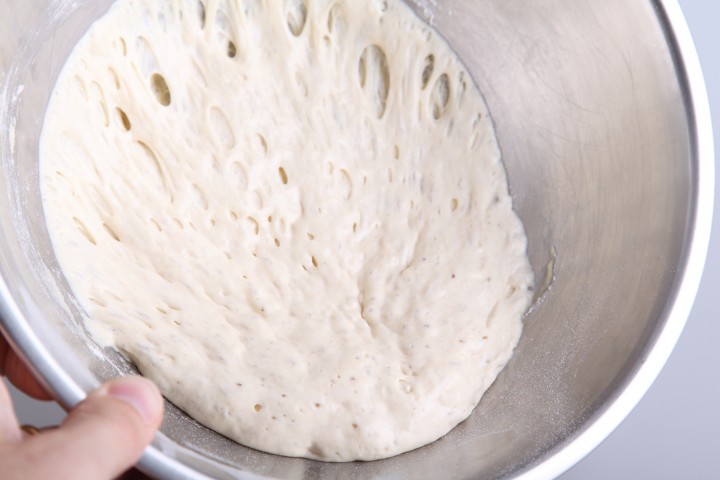
What is it?
There are several traditional methods for creating starters for breads. All of these starters are easy to prepare.
A starter usually consists of a simple mixture of wheat flour, water, and a leavening agent (typically yeast or a sourdough culture). After mixing it is allowed to ferment for a period of time, and then is added to bread dough as a substitute for, or in addition to more yeast. So pre-ferments are critical for best tasting bread – You can call it a starter, biga, poolish, preferment, or sponge – they all do sort of the same job and only really differ by water content.
Biga and poolish are terms for pre-ferments used in Italian and French baking, respectively, for sponges made with domestic baker’s yeast. Poolish is a fairly wet sponge (typically made with a one-part-flour-to-one-part-water ratio by weight), while biga is usually drier. Bigas can be held longer at their peak than wetter sponges, while a poolish is one known technique to increase a dough’s extensibility.
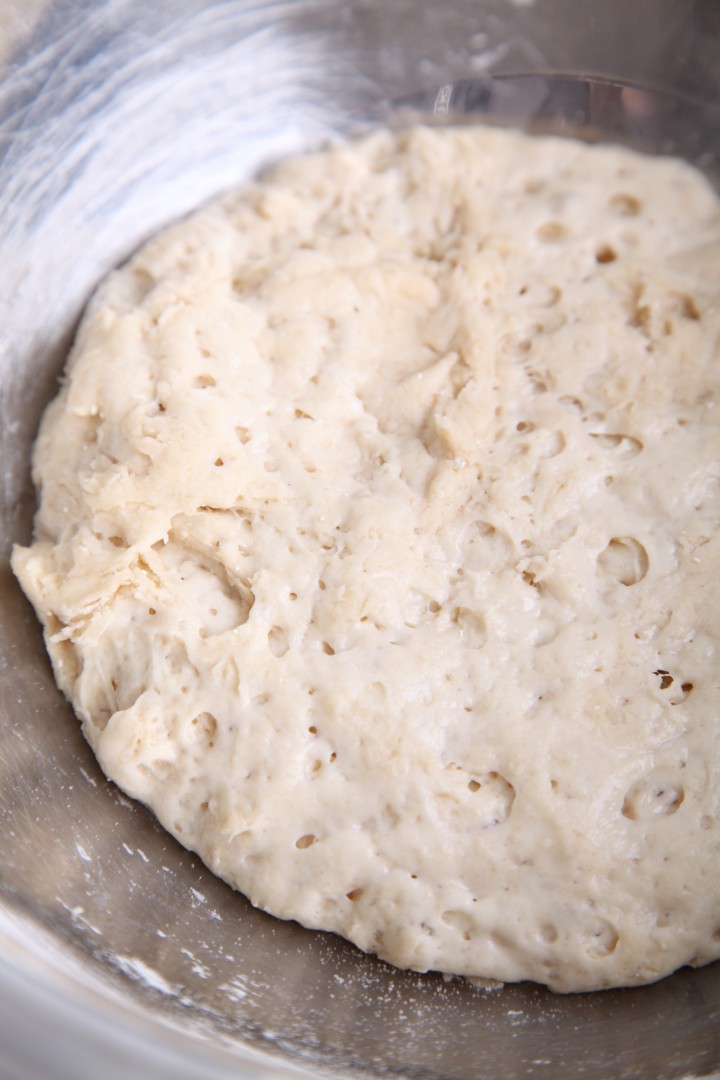
Why use it?
The primary difference between making bread with a starter and making bread with the direct or straight yeast method is that starter breads require much more time to prepare, but the flavor and texture of the bread is almost impossible to achieve with other leavening methods. Bread made with starters like poolish and biga also tends to keep better, compared to bread made from straight doughs.
Poolish & biga tips
- If you are working with pre-fermented doughs like poolish or biga make sure not to ‘over ripe’ your pre-ferment. This is especially true when using larger percentages of preferment in your final dough (think up to 50%) because over riping will kill the gluten in your preferment (the yeast will eat them all) and you will end up with a weaker and hard to handle dough.
- The higher the percentage of pre-ferment you use the more your bread crumb will have a nice chewy texture (but it stops at around 50%). We like our bread that way, it gives you something to chew on. The sugars that are released from the flour in the pre-ferment also add a nice golden colour to your bread.
- Yes you can make the same bread recipe using a biga or a poolish, you just need to make sure you adjust the water content.
- You can make a poolish or biga from another type of flour than the one you are using for the actual bread. For example, we use spelt, rye or whole wheat flour to add extra (and different) flavours to our bread.
Percentage of instant dry yeast in poolish
You can prepare your poolish up to 8 hours but also up to 16 hours in advance. But you have to adjust the amount of instant dry yeast you use. Logically, the more time a pre-ferment gets, the less yeast you have to use.
This is the schedule we use
Poolish up to 8 hours in advance – 0.23% – 0.33%
Poolish up to 12 hours in advance – 0.1% – 0.2%
Poolish up to 16 hours in advance – 0.03% – 0.08%
Example – How to calculate the right amount of yeast
You make a poolish consisting of 200 g flour and 200 g water. You make it 12 hours in advance (typically the night before the morning of baking) and it is summer or a nice warm room temperature for the poolish to ferment in.
You calculate the amount of instant yeast needed as follows:
amount-of-instant-yeast = amount-of-flour / 100 x percentage-of-table
For example;
200 g (amount of flour)
0.1% (yeast amount used in summer for 12 hour poolish)
To calculate 1% of 200g of flour you divide 200 g by 100 and multiply by amount in the table;
200 / 100 x 0.1 = 0.2 g instant yeast
(for fresh yeast multiply the amount by 3)
What does 0.1 gram of yeast look like?
To give you an idea of how tiny the amount of 0.1 gram of instant dry yeast is we have made some pictures. The third picture shows 0.1 grams of yeast in a teaspoon, the last picture shows 0.1 grams of yeast in a 1/4 teaspoon.
To give you an idea of how much instant dry yeast goes into a measuring teaspoon:
1 tsp dry yeast = 3.1 g
1/2 tsp dry yeast = 1.6 g
1/4 tsp dry yeast = 0.78 g
Also check out our recipe for pizza dough with a poolish
Find our favorite bread recipe with a sourdough culture based poolish here



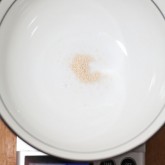
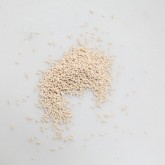
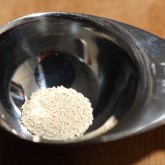
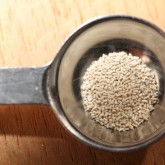

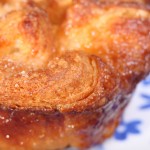
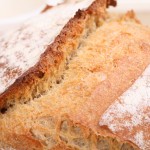

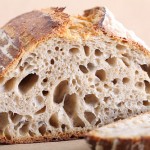
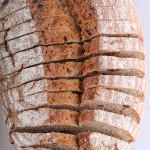
David liu says
Great insights and helpful calculations, thank you! Wonder if you can discuss how cold fermentation affects yeast amounts.. for example, ive been using a pizza recipe calling for a poolish with 1hr @rt, followed by overnight in the fridge with great results, but would like to be able to manipulate the time of and post fermentation.
Weekend Bakers says
Hi David,
Maybe the table with yeast amounts, and corresponding times and temperatures we provided with our pizza dough recipe will be of help to you:
www.weekendbakery.com/posts…gh-recipe/
Jenny says
Hello. I want to replace dry yeast with levain in biga. The recipe calls for 3/16 tsp or 0.64 g of dry yeast in a total of 800g flour and 544g water and 22g salt. Can this be done? I currently make poolish with levain but haven’t used biga before so I’m not sure how to adjust. Is there a formula for swapping out?
Weekend Bakers says
Hello Jenny,
You can use the same amount as you use in your poolish. For the biga, use the same amount of flour and levain, just less water, so in short you just get a stiffer preferment (which is usually done if you want to be able to hold it longer at a certain peak).
Good luck with it!
Peter Feldman says
this is great information.
Question- if I want to replace instant yeast with biga, can I and how much should I use?
Weekend Bakers says
Hi Peter,
Sorry, we are not really able to answer this question well without knowing which recipe you want to adapt from. A biga, in general, is also made with instant yeast.
In general you can take any yeast based recipe, and decide about the percentage you want the biga to be of the total. Then you make sure the amounts of water and flour used in the biga are subtracted from the total amount, so it all adds up. So part of your flour and water are already in the biga and the rest you add when you make the final dough. Like we say in the post, you can take any amount between around 20 and 50% of the total. The amount of yeast you add to the biga and final dough depends on the method, temperature and time / timing you use for development.
Calvin says
I have a few questions:-
1. I am using total 300g flour for the dough, how much poolish I should create? 10%? 20% or? And those flour use in poolish has to be deducted from the total flour, right?
2. Still using the same schedule you mentioned here to calculate the amount of yeast? For example, I use 10% of total flour, 30g for the poolish, and I am going to preferment for 12 hours, 0.2% of instant yeast will be 0.06g lol
3. If I use a 12 hr preferment poolish, can I still put the dough in the fridge for cold retard overnight?
Bev says
Hi, I want to make a polish this evening to bake a baguette in the morning. Does the yeast go in the polish tonight or is it adding when making baguette in the morning please?
Weekend Bakers says
Hello Bev,
You put the (small amount) of yeast in the poolish to let it preferment before adding it to the final dough.
Also check our baguette recipe(s) to see our method:
www.weekendbakery.com/posts…te-recipe/
cheryl says
Can you refrigerate the Poolish and if yes how long?
Weekend Bakers says
Hello Cheryl,
Yes you can. With a recipe you first decide what the amount of poolish will be from the total dough, then you decide how long you want to let it ferment in the fridge. With this comes a percentage of yeast to use.
Look at the table with this recipe from which you can calculate the amount of yeast needed for a certain time and temperature.
www.weekendbakery.com/posts…gh-recipe/
Saskia says
Hi. Can you use these methods with Gluten free flours. I normally use Brown rice, sorghum and millet flour for my sourdough. I know a biga is different from a sourdough but more asking re GF.
Weekend Bakers says
Hello Saskia,
We are no experts, but maybe you can find inspiration here:
www.thefreshloaf.com/node/…preferment
Hope it will be a success!
Kevin Sheffield says
Great article. That is it is concise well informed and nicely written. A longer one would be better!
Thank you
Nicklas says
I’ve recently just started to bake with Biga & Sourdough just to experiment.
But i can only do it when i’m following a recipe where the measurements are described.
Do i understand it correct – if lets say you have a recipe where you have to use 1000gr flour and 700gr water, and you make a biga 50% with 200gr flour 100gr water – do you just do simple math and add the biga with now 800gr flour and 600gr water?
Thanks.
Weekend Bakers says
Yes Nicklas, you simply subtract the amounts for the biga from the total amounts flour and water exactly like you say!
Nicklas says
Perfect, thanks for the quick reply.
What about the size of the biga, is that up to individual preferences? I mean if you take my example from above, what if you make 400gr flour 200gr water for the biga would that make any difference in a good or bad way?
Weekend Bakers says
Hi Nicklas,
That is the fun part, you can try anything between 10 and 50% of the total and get a different result each time. See what you like, and what the recipe indicates. A larger preferment also means a larger portion of the dough is of course ‘prefermented’ which means the starch in the flour gets broken down into ‘sugar’ making the bread easier to digest, which can be a good thing for many people. Put sourdough loaves already have long proofing times, also the final dough, so this process also occurs in this phase.
Experiment, make notes and have fun!
Nicklas says
Again thanks for the quick reply, i will try it out and see where it gets me!
Adam says
My poolish doubled in 2 hours and went flat at 4 hours. What happened?
Weekend Bakers says
What poolish for what recipe please? This could be a case of too much yeast and over-proofing.
Peter Flynn says
Thanks for this, it sounds really useful.
If I make a biga like this, how much of it do I need to use for (say) a loaf using 500g flour?
What do I then need to add back to the biga so that it will be ready to contribute the same the next day (or day after)?
Weekend Bakers says
Hi Peter,
First decide what % you want the biga to be of the final dough. Then make one with 100% flour and about 60% water. So if you want 200 grams of flour for the biga you add 120 grams water and substract both amounts of ingredients from the amounts of the final dough.
Gaby says
Hello, thanks for such a clear and useful explanation. I have one question. After preparing the poolish; when adding the remainder of the original recipe’s ingredients, how much of the original yeast do you add? Is it all the yeast less what went in the poolish or is it a reduced quantity? Thanks
Weekend Bakers says
Hello Gaby,
Thank you. It is usually a reduced quantity, but it depends on the recipe / method. A good guideline if you want to experiment is to use about halve the original yeast in the final dough and take it from there.
Enjoy your baking and loaves!
Gaby says
Thanks 🙂
jane says
Hello, I have recently started making a loaf with a poolish ferment. I understand its wet but the recipe I am following (which does make a tasty semi chewy loaf) is also unbelievably wet to the point that when I shape it i am forced to add more flour. Usually bread recipes are 3 parts flour to one part water. the recipe i am following is roughly 2 parts flour to one part water. Is there any way to make this dough easier to handle?
Weekend Bakers says
Hello Jane,
We can recommend looking at our tips for handling high hydration dough:
www.weekendbakery.com/posts…ion-dough/
Resist the urge to add much flour, because you will get a different result in the end.
Per says
Hello!
I recently started to use poolish for my breads, and it is such a great method to get really tasty breads. And I find it much easier to work with compared to a sourdough (I have never had any success with sourdoughs because they always die).
However, I have a question and hopefully you can help me out. Some recipes that I would like to try is based on sourdough. How do I convert the amount of sourdough into a poolish?
For example one recipe is based on 1000 g of water, 1500 g of dinkel wheat and 100-400 g sourdough. How could I convert that into poolish?
I would love to find an easy way of converting sourdoughs into poolish!
Thank you for a great website!
All the best,
Per (from Sweden)
Weekend Bakers says
Hello Per,
We cannot really answer this question well because the method for a sourdough loaf is different with different proofing times and we do not have enough info about your recipe and the times for the prefermenting you want to do.
We also do not understand the 100-400 g sourdough?
Wat % of the total dough do you want to have as a poolish? Is it going in the fridge or at room temp and for how long?
Also keep in mind that turning a sourdough loaf into a yeast-based loaf will always generate a very different result.
We would suggest establishing the amount of poolish and using a table like the one in this post to calculate the amount based on the temp and duration of the fermenting:
www.weekendbakery.com/posts…gh-recipe/
Thank you for your kind words and keep on baking!
Ed & Marieke
WKB
Robert Lilja says
Great write up!
Weekend Bakers says
Thank you Chef!
Richard Huhn says
Hi – can a poolish be propagated like a sourdough starter, perhaps with a different frequency of maintenance?
Weekend Bakers says
Hello Richard,
If you mean maintaining a poolish with sourdough you can in fact continues use it and bake with it every day. This is what professional artisan bakers do too. Because they know they will use and need these amounts every day. If you bake irregularly you will waste a lot of flour every day just maintaining it, throwing away a lot of over-ripe poolish. This is why we use the maintaining of a small amount culture method and with this we create a poolish overnight to use in the end dough.
You can read more about our two step method here:
www.weekendbakery.com/posts…ough-tips/
cheryl says
Do you have info on making the sourdough culture.
Weekend Bakers says
Hello Cheryl,
Yes we do, you can find our instructions in easy steps here:
www.weekendbakery.com/posts…asy-steps/
Enjoy your sourdough baking
cheryl says
Thank you for this info. Very helpfull
Uzo says
Hello,
Great article. Is it imperative to add dry yeast to the poolish? Can you still utilize the poolish method without the use of dry yeast? Thanks in advance!
Weekend Bakers says
Hello Uzo,
You need some form of yeast to get the fermentation going. So you can use instant but also fresh yeast or use a bit of your sourdough culture. This is demonstrated in our Pain Rustique recipe, which is a ‘hybrid’ bread that uses sourdough in the poolish / preferment and a bit of instant yeast in the final dough. If you want to use fresh yeast instead of instant / dry yeast, you have to use about 3 times as much, so in general 1 gram instant yeast equals 3 grams fresh yeast.
Mauricio says
Hello! I found the recipe below on the New York Times for poolish that I intend to use for another baguette recipe. I was wondering if someone could explain to me what an organic white flour “with retained germ” is? I can’t find a clear answer online and I’m not sure if it would technically be considered wheat flour?
1 cup minus 2 tablespoons room-temperature water
3/4 teaspoon crumbled cake yeast
2 cups organic white flour with retained germ
Thank you for all your help.
Weekend Bakers says
Hello Mauricio,
The germ is part of the wheat kernel. Extra wheat germ is added for taste / flavor. The whole wheat flour (containing 100% of everything in the grain, including the germ and bran) is being sifted and a certain percentage of germ is later added to the white flour.
Yes, this is also called wheat flour but there will be an extra addition to the name like French type 65 ‘Emeraude’ for instance to indicate the germ is added.
To make your baguettes it is not really necessary to buy this flour, you can also use a good quality (organic) wheat flour with around 12% protein, or buy the wheat germ separately and add some to the flour.
Hope this helps.
Enjoy your baking and baguette baking
Linda says
Hi there, I started a poolish 4 days ago for sourdough bread, I want to use some of it for pizza dough. Can you please recommend how much (preferably I grams) I would require for this recipe.
Thanks
Linda
Weekend Bakers says
Hello Linda,
Do you mean you started a sourdough culture and want to make sourdough pizza?
Ronita says
Is the pollosh be fed every day and you keep it or just make it ehen you want to make the bread?
Weekend Bakers says
A poolish is just made several hours before the final dough and then added to that final dough. The one you feed every day is a sourdough starter culture. You can see how you can make such a culture yourself here: www.weekendbakery.com/posts…asy-steps/
Chloe says
Hii!
For the preferment poolish and biga , is it better to put them at room temperature or in the fridge?
And when we’re going to use it, the preferment must not be cold right?
Thankyou!
Weekend Bakers says
Hello Chloe,
It is both right, it depends on the method and recipe. So one is not better than the other. It is a combination of time and temperature that dictate the amount of yeast or sourdough culture you use.
If you use a cold preferment and your final dough needs to be a certain temperature, you can use warmer water in your final dough to get the total temperature right. It is not ‘wrong’ to use a cold preferment, depending on the temperature of your room and other ingredients, adding something cold would just mean it would take a bit longer for the dough to proof.
We think our tips on dough temperature might be of help too:
www.weekendbakery.com/posts…mperature/
Enjoy your baking!
Stefan G says
A fantastic site for baking! I have spent most of the evening browsing through recipies and tips.
I have one specific question just now (will probably have more when I get on to trying your recipies). You use weight for all ingredients which of course is the easiest and most precise measure. But isn’t there a risk with weighing the flour since the water contents will vary with the relative and absolute humidity of the air? Do you adjust for it in any way? I have noticed that the dough consistency varies depending on the season when I use wheighing, but perhaps the problem is greater here up in the north (I live in Sweden) with greater difference humidity between winter and summer. /Stefan
Weekend Bakers says
Thank you Stefan, for your kind words. Yes, we always adjust, because it is never quite the same, so based on experience with a recipe and using your eyes and hands you make small adjustments all year long. But we think you are right that your conditions will have an even greater effect than ours. We weigh everything, we weigh the water, but always keep some back when adding, seeing how the dough comes together and then decide what to add.
Enjoy your baking!
Greetings from Holland,
Ed & Marieke
Ellen Isaacs says
Hi, my poolish has been sitting in a small, warm-ish room for 17-1/2 hours – and a bit of it will not float in a small bowl of warm water. Help!
I’m using a Bon Appetit recipe as follows:
1/8 tsp (1/2 packet) dry yeast
117 grams whole wheat flour
75 grams rye flour
42 grams all-purpose flour (I used King Arthur)
Weekend Bakers says
Hello Ellen,
We never use this floating method, we look for since of bubbles and growth, so how does it look? Do you see any activity, has it risen or is there maybe a rim left in the bowl and has it already risen too far and collapsed again?
If your poolish shows activity you can go ahead and use it, even if it is not yet to its full potential, it is always better to use it under-proofed than over-proofed, because it will get more time in the final dough and you will always get a good loaf this way.
Also check your packet of yeast for its date and make sure it was properly sealed so it is still of good quality when used.
Good luck with it and hope you will enjoy your baking!
Lolie Acorn says
This all sounds like rocket science to me. I’m a great baker and cook, but I’ve never ever made bread. With all this self isolating, I thought I’d give it a go … I can’t get past why / what a “starter” is. Seems complicated. Don’t you just bake bread with a packet of yeast???
greg says
Lolie you can bake bread with a packet of yeast. The yeast you buy has been selected to produce a consistent rise fairly quickly. You can make really nice bread just with that.
But you can dramatically improve the flavor of your bread by not following the directions on the yeast. For example, you could use half or quarter the amount of yeast recommended and let your bread rise for a much longer time. Or you could put it into the fridge, rather than let it rise in a warm place.
Why would you do that? Because the flavor comes from the gasses produced by the yeast and bacteria and the longer the fermentation time, the better the flavor. The key there is that people are sacrificing some convenience and speed for better flavor.
And once you’re willing to do that, you can do a lot of other things too. That’s why people make a pre-ferment or a biga or a poolish – those are all ways to make your bread taste even better. And then you’ll change your ratio of liquid to flour. And before you know it you’ll find that you’re also changing the texture of the finished bread into something completely different.
My suggestion is that if you haven’t made bread, do it with a packet of yeast a few times until you’re comfortable. And then start experimenting.
Best of luck and happy baking!
Stephen says
What a nice and thoughtful reply. Thanks
Weekend Bakers says
Thank you so much Greg, hope you are enjoying your baking as much as we do these days. A rewarding skill to bring joy if ever there was one!
Ed & Marieke
Poul Lausen says
I never bake without poolish or biga because the taste is addictive.
A tip: put a little rye and whole wheat in the poolish, 25g of each is enough for 150g bread wheat and 200 g water. Give the poolish 24 h in the fridge.
For the moment I test a 72h biga, 50% (half of water compared to flour)
Weekend Bakers says
Thank you for this tip Poul, we very much agree and it is fun to do these test with different grains.
Weekend Bakers says
Hello Lolie,
We do not have anything to add to the very true and helpful comment made by Greg except that we hope you will start baking and will notice it is not complicated. You can even start with a no knead bread (No kneading required, only stirring and waiting) which is so easy to do I even got my brother baking and enthusiastic.
Take a look: www.weekendbakery.com/posts…istachios/
Then, if you like it, move on to these white buns that everybody loves:
www.weekendbakery.com/posts/white-buns/
Enjoy your baking adventure and stay safe!
Sweta says
Hi …
I want to know how do we know when the poolish is over fermented ?
Weekend Bakers says
Hello Sweta,
You can see a rim in your bowl that indicates the poolish was a t a certain level and after that it withdrew, leaving behind this edge of dough. When it is really over fermented you also see the poolish is turned into ‘soup’, so very thin, without any ‘gluten-network’ to hold it all together. So it is always better to use an under-proofed poolish with gluten still intact to make a good quality dough.
Sam Ciarcia says
I have been making Artisan bread for a while . I use 500 grams bread flour , 2 grams Fleischmann’s instant dry yeast , 400 grams water & 10 grams salt . I do no kneading , just 4 folds every 1/2 hour and then let it ferment 12 to 14 hours where then I bake it at 450 deg in a Dutch oven . All measurements with a digital scale . The bread comes out superb . My question is , Is the bread I make a real sourdough bread even though I don’t make my own Biga or Poolish ?
Weekend Bakers says
Hello Sam,
Because you use commercial instant yeast, your bread cannot be called a sourdough bread. For this you would have to use a sourdough culture which is made using flour and water and let the ‘wild’ yeast that is present on the flour come to life (so this yeast is not the same as the one you buy in a packet). You can check out how we make our own culture here: www.weekendbakery.com/posts…asy-steps/
A poolish or biga can be made both by using instant yeast and sourdough culture, it is a choice you make, but it will only be true sourdough bread when you make a poolish with your sourdough culture.
MaryAnn says
I added dry yeast to my sourdough starter so do I add yeast .like the recipe calls,or do I have enough with what’s in the starter?
Weekend Bakers says
Hello MaryAnn,
Just to make sure there is no confusion, which recipe are you making? If you are making a 100% sourdough loaf, you will never add any (commercial) instant yeast. There are also hybrid breads where you for instance use your sourdough starter for the preferment and use a bit of commercial yeast in the final dough to aid with the (quicker) proofing of the bread.
Susie says
Thank you for such detailed and clear encouraging advice.
Weekend Bakers says
Thanks Susie, glad you find it helpful.
Rien says
Great, somebody knows what they are talking about, all those simple and easy bread recipes that abound on the internet just don’t get the real chewy bread results.
Weekend Bakers says
Thank you Rien, much appreciated! Enjoy your baking.
Sherron Hall says
I made a starter tonight for a bread recipe that I will make tomorrow. It called for 1/2 C water
1/16 tea. yeast
1 C flour
It does not look like the ones pictured, like a stew consistency, but rather a blob of dough in the bottom of a bowl. I covered it with stretch plastic and will see what happens by tomorrow morning. Should be interesting as it said COOL water, not room temp.
Weekend Bakers says
Hello Sherron,
It does not truly matter if you use cool / cold water or room temperature water other than in relation to the time it takes for a preferment to develop. So it is always a combination between amount, temperature and time.
Also see our handy table for the percentage of yeast you need in relation to time and temp here: www.weekendbakery.com/posts…gh-recipe/
Hatem Amer says
Everytime I use a poolish (with anywhere from 33% to 50% of total flour) I tend to lose too much strength and I end up with a much stickier ball of dough than I normally would with a similar hydration without the poolish. I am unsure if my dough handling skills are lacking or if it’s the dough that’s unworkable. Am I overriping the preferment everytime or is this to be expected (to an extent)?
Weekend Bakers says
Hello Hatem,
We do not know what recipe you are using but it is our experience that the cause would be an over-ripe preferment with damaged gluten as a result. Try and use a slightly under-ripe poolish and see how this goes. You can also try different (brands) flours and see if this makes a difference.
Chris says
Jeez, this is all so precise. I just feed my starter every day for 3-4-5 days. Dump it in with 50/50 flour/water. Let it foam overnight, make a new starter with a bit of the poolish, then mix a few cups of flour with some salt. 3 1/2 cups to 1 tsp is my general rule. Add that to my remaining poolish and mix until shaggy… adding water/flour as kneaded (pun intended). Let rise. Punch and shape. Rise and bake. Never get a bad loaf but can’t prepare for variance, just watch what is happening.
Does anyone else wing it more, precision less? My starter is roaring for tomorrow’s turkey feast.
Weekend Bakers says
Yes, you are right Chris. Most people need ‘holdfast’ at first, but with experience and knowledge and making it your own, you can let loose. But it helps to have good directions and a solid starting point. Plus we are talking commercial yeast amounts here in the above article, not sourdough cultures.
Miss E J Clarke says
What percentage of yeast do we then add to the rest of the dough ? I prefer fresh yeast, but have active dry as backup.
Weekend Bakers says
Hello Miss E J,
That totally depends on what recipe you are making and the time table, use of fridge or room temp et cetera. If you want to use fresh yeast that is never a problem.
Converting from instant dry to fresh yeast you multiply the weight of the instant dry yeast by 3
Converting from fresh yeast to active dry yeast you multiply the weight of the fresh yeast by 0.4
Converting from fresh yeast to instant dry yeast you multiply the weight of the fresh yeast by 0.33
Converting from instant dry yeast to active dry yeast multiply by 1.2
You can also use our yeast converter (under multiconverter) on this page:
www.weekendbakery.com/cooki…nversions/
Radu Popescu says
Let’s say that one has a recipe that wants to convert to incorporate pre-ferment, so move it from bulk fermentation to biga or poolish based with a pre-fermentation step.
In the original recipe (for focaccia):
– 400g flour
– 260g (ml) water
– 30ml olive oil
– 7g salt
– 7g instant dry yeast
This is for the dough only – there’s more olive oil for brushing and salt being used when shaping and just before baking.
I converted this the following way:
– poolish
– 100g flour
– 100g (ml) water
– 0.66g yeast
– mix in a plastic food container, ferment for 8 hours
– final dough
– poolish from above
– 160 g (ml) water (=260 – 100)
– 300 g flour (=400 – 100)
– 30ml olive oil
– 7g salt
– 5g instant dry yeast
– this was: mixed, kneaded, risen, shaped, risen, baked, with rising times about 60-80 minutes at around 22-23C.
So overall 1.34g less yeast was used, and the same total quantity of water, flour, olive oil.
It came our really nice.
Does this sound right?
Weekend Bakers says
Hello Radu,
Yes, this is exactly how it goes, very good. And you can play with the quantity of poolish too, up to about 50% of the total is best in general.
Enjoy your baking and experimenting
Radu Popescu says
Thanks!
I was thinking of doing this for a classic brioche dough, but the recipe I have (from Le Cordon Bleu training manuals) uses no water at all, it’s 125ml milk to 500g flour, and other ingredients (sugar, salt, eggs, yeast, butter – 250g oh my!).
Can poolish be made in such situation, and how, with milk? Many thanks!
Weekend Bakers says
Hello Radu,
We would suggest to use this recipe as described, because it will be a classic way of making a brioche. We would not make a poolish for this but would make the complete dough and retard it in the fridge. We never make a poolish with milk and have not really seen it used.
Radu Popescu says
Dank u well, much obliged! All the best!
Weekend Bakers says
Graag gedaan / you’re welcome 🙂
John Roach says
This is the schedule we use
Poolish up to 8 hours in advance – 0.23% – 0.33%
Poolish up to 12 hours in advance – 0.1% – 0.2%
Poolish up to 16 hours in advance – 0.03% – 0.08%
Are the percentages correct? Are you trying to say 23% to 33% etc?
If so, 0.23% is not the same as 23%.
0.23% < 1%
To calculate 1% of 200g ……: The answer to this is 2g not 0.2g
You are also talking about 0.1g . Should this be 1g? They are not the same thing. How does one measure 0.1g with kitchen scales?
Weekend Bakers says
Hello John,
The amounts are absolute Correct!
Yes the amounts are tiny, that is why we show you how small the amounts are with the pictures too, the last picture in the gallery showing the tiny amount of 0.1 gram in a quarter tea spoon measuring spoon. You only need these small amounts because the yeast has lots of time to multiply in the hours it takes to ferment.
And yes a kitchen scale usually cannot measure below 1 gram. That is why you need a precision scale that can measure tenth of grams.
Hope you understand what we mean and can use the method, because it is wonderful to use in bread baking and saves a whole lot of yeast.
Michel Simoneau says
I like to use small measuring spoons. For instant dry yeast i’ve measured
tad = .8 g
dash = .3 g
pinch = .2 g
smidgen = .1 g
Weekend Bakers says
Thank you for sharing Michel, for us Dutch people it is hard to translate words like Tad and Smidgen into words that would indicate the same. I think the smidgen would be our ‘snufje’ so maybe there’s a connection in the language too. Like cookie comes from our word ‘koekje’.
John says
Hi, is there a good indication of when the poolish is at the optimal size to use? For example, should I use it when it is twice or 1.5 of the original volume?
Weekend Bakers says
Hello John,
We would not use volume as an exact indicator, although you will see your poolish visibly grow and climb in your bowl. We always look at the activity. First you have a few bubbles, then more bubbles and at a later stage you also see foam and after that you will see the poolish ‘retreating’ visible by the rim of dough left in the bowl while the rest of the poolish is already lower. The optimum time to use it would be when you have many active bubbles but not yet the foam.
It is always better to use the poolish that is slightly under-ripe than over-ripe, because you can still take more time for development with your final dough but can never compensate for the gluten being damaged by over-fermentation.
Leandra says
Could I use regular dry yeast instead of instant and use warm water instead of cold water?
Weekend Bakers says
Hello Leandra,
We guess you want to use what is also called active dry yeast that needs to be dissolved in water before use. Yes of course you can, as long as water is never too warm as to harm the yeast. To convert from instant dry yeast to active dry yeast you also need to use a bit more and multiply the amounts we give by 1.2, so use 20% more than we do in our examples.